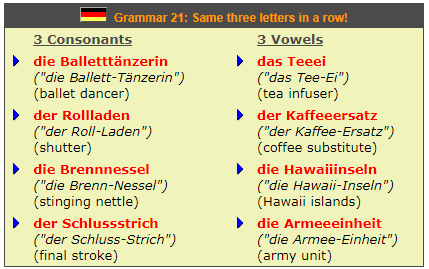To avoid clumsy repetition, German uses hyphens in a list of compound nouns to represent those elements that are common to all nouns in the list:
Grammar 20: Lists of compound nouns
Drei- und Vierbettzimmer
(Implied: "Dreibettzimmer und Vierbettzimmer")
(Translation: "rooms with three and four beds")
PC- und Telefaxanschluss
(Implied: "PC-Anschluss und Telefaxanschluss")
(Translation: "PC connection and fax connection")
Schlaf-, Wohn- und Arbeitsbereich
(Implied: "Schlafbereich, Wohnbereich und Arbeitsbereich")
(Translation: "sleeping area, living area and working area")
Vegetarier- und Kindermenü
(Implied: "Vegetariermenü und Kindermenü")
(Translation: "vegetarian menu and children's menu")
Hyphens and compound nouns
Hyphens are also used to break up individual compound nouns that would otherwise be difficult to read. This is particularly true in compound nouns were one element is an abbreviation such as "der PC-Anschluss", "der/die HIV-Infizierte" (= HIV-infected person) or "die VIP-Lounge" (= VIP lounge).
One of the changes introduced recently in the German spelling reforms has made it possible to have three (!) of the same letters in a row in a German compound noun. This occurs when the first element of a compound noun ends with a double letter and the second element of the compound noun starts with the same letter. Before the spelling reforms, only two of the three letters would have been written. It is still an accepted variant however to split up such compound nouns with a hyphen, and this version is more common when you have three vowels in a row.

 英语
英语 日语
日语 韩语
韩语 法语
法语 西班牙语
西班牙语 意大利语
意大利语 阿拉伯语
阿拉伯语 葡萄牙语
葡萄牙语 越南语
越南语 俄语
俄语 芬兰语
芬兰语 泰语
泰语 丹麦语
丹麦语 对外汉语
对外汉语

